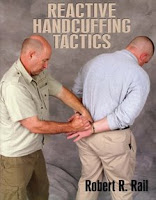“Reactive Handcuffing Tactics” by Robert R. Rail, Ph. D., 2006. 56 Pages, Softcover, 8-1/2” X 11”, 66 Photos.
Handcuffing an individual is a frequently used and vital skill for most law enforcement officers, yet scant little has been written about how to properly apply handcuffs. REACTIVE HANDCUFFING TACTICS goes beyond just simple instructions.
The techniques described and depicted in this book blend restraint equipment with reactive, bio-mechanical techniques that will enable you to safely and effectively control a subject. These step-by-step instructions – each illustrated with photographs – provide you with a controlled alternative to force beyond need. They enable you to humanely restrain compliant, resistant, and even combative subjects using the least amount of force needed to achieve compliance.
REACTIVE HANDCUFFING TACTICS combines the twin goals of officer safety and arrestee welfare in a quick and efficient method. They are realistic and practical restraint techniques that do not sacrifice effectiveness and officer safety for liability protection.
This book begins with the fundamental techniques for handcuffing a non-resistant subject; probably the most common type of arrest and restraint. But at any stage of the cuffing procedure, a subject may choose to resist or even attempt to attack you. There are several specific examples of when and how a subject may choose to resist or attack and detailed instructions about how you can quickly and effectively defeat subject resistance without the use of excessive force which would endanger you and the subject, and increase your potential legal liability.
The most important part of law enforcement is officer safety and the most important part of officer safety is consistent and proper training! From the very beginnings of policing through the complexities of our modern times, training has been an integral part of law enforcement. The old adage of “how we train is how we will react” is true. The proper application of handcuffs is more than just getting the equipment on a subject; you must also consider the bio-mechanical limits of the offender and the “rules” that govern the use of force. Therefore, it is very important that you begin REACTIVE HANDCUFFING TACTICS training by reading carefully the CAUTIONS and USE OF FORCE sections of this book. These two sections will guide you in your training and in the safe application of handcuffs.
Applying handcuffs to any subject can be dangerous. You never know when a seemingly compliant subject will suddenly turn resistant or even combative. Included in this book is a section title THE ATTITUDE OF CONFRONTATION which will give you some insight into how body language can tip you off to a subject’s intentions. Being able to read a person’s body language will help you in any situation in which you are dealing one on one with another individual.
TABLE OF CONTENTS
Introduction
Cautions & Safeguards
Use Of Force
The Attitude of Confrontation
Handcuffing a Cooperative Subject
Handcuffing a Resistant Subject
Prone Straight Arm Brace
Rear Walk Come-Along
Introduction
Cautions & Safeguards
Use Of Force
The Attitude of Confrontation
Handcuffing a Cooperative Subject
Handcuffing a Resistant Subject
Prone Straight Arm Brace
Rear Walk Come-Along
Dr. Robert Rail is an internationally recognized trainer and expert on police tactics and interpersonal relations. He is a former U.S. police officer who has served as a law enforcement trainer in Bosnia, Kosovo, and Iraq. He has taught his “understanding body language” techniques and methods to law enforcement and military personnel from more than 50 countries. He is author of three other books, Defense Without Damage: A Photo-Illustrated Guide to Low-Liability Arrest and Control Skills, Custodial Cuffing & Restraint, and The Unspoken Dialogue: Understanding Body Language and Controlling Interviews. He also serves as Director of Training for Hiatt-Thompson.
